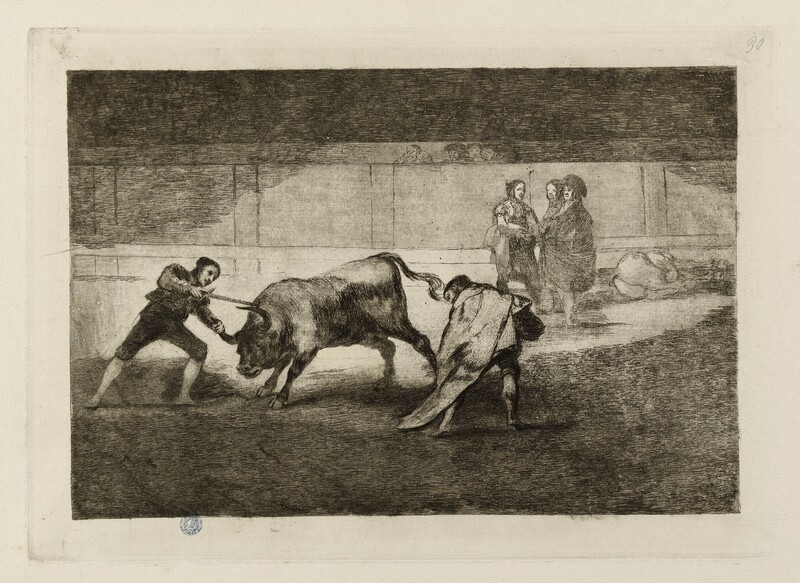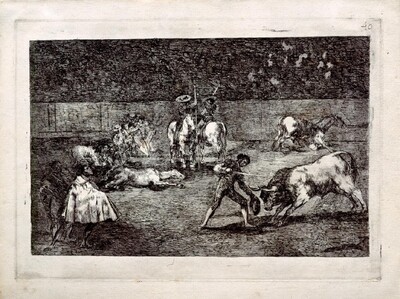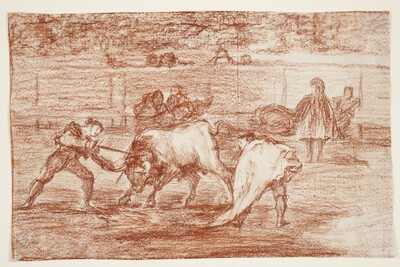- Cronología
- 1814 - 1816
- Dimensiones
- 249 x 347 mm
- Técnica y soporte
- Aguafuerte, aguatinta, punta seca y buril
- Reconocimiento de la autoría de Goya
- Documented work
- Ficha: realización/revisión
- 03 Oct 2021 / 22 Jun 2023
- Inventario
- 225
30 (pen, upper right-hand corner)
Dutuit Collection identification stamp (stamped in blue ink, bottom left-hand corner)
See How the ancient Spaniards hunted bulls on horseback in the countryside
This work is one of a group of five prints discarded by Goya and not included in the first edition of the Tauromaquia, of which the copper plates have not survived, so they could not have been included in later editions of the series, as was the case with the seven that Loizelet added in 1876 in the third edition. Of the five prints mentioned above, identified by Gassier with the letters H-L, only a few state proofs and their preparatory drawings have survived. Of a sixth print, of which the copper was never opened, only the preparatory drawing is extant.
Only one proof of the present print has survived, with the etching, aquatint, drypoint and burin, in the Dutuit Collection at the Musée du Petit Palais in Paris (GDUT 5439). This state proof entered the Musée du Petit Palais in 1902 as part of the bequest of the brothers Auguste and Eugène Dutuit, although in the past it had belonged to the Madrid collection of Valentín Carderera, who acquired it from Mariano Goya, the painter's grandson, and later to the Galichon collection in Paris.
See How the ancient Spaniards hunted bulls on horseback in the countryside
In this scene, which is very brightly lit in the central part, we see a bullfighter holding the horn of the bull in front of him with one hand while with the other he holds the rapier and proceeds to thrust it into the bull. Another man with a large cape, no doubt a subordinate, seems to be moving away from the action, although he is in the foreground of the composition. In the background, in second plane, we see a curious group of characters who are inside the bullring but seem oblivious to the danger, as they observe the action as if nothing could happen to them, although behind them lies a dead horse. These characters are dressed in a curious manner, especially one of them, who wears a large hat and cape. Behind them we see the barrier and the bullring, in which a small group of spectators can be seen in the lower part but not the mass of the audience, which is barely outlined, as this area is vary darkened. The figures in the foreground are in shadow inside the ring.
Because of the luck depicted, the work is thematically related to two other prints by Goya of bullfighting and its extensions that reflect the luck of the kill or supreme luck: Pedro Romero killing a standing bull and A bullfighter entering to kill with a hat in his hand instead of a muleta (Bullfighting I).
There is a preparatory drawing of the present print, also titled A killer sinks his rapier by grabbing the bull by the horn (Bullfighting L)
-
París1986
-
Goya: toros y torerosEspace Van GoghArles1990displayed also at Academia de Bellas Artes de San Fernando, Madrid, consultant editor Pierre Gassier.
-
París2008
-
OxfordBruno Cassirer1964vol. II, 1964, p. 362, cat. 247a
-
Vie et ouvre de Francisco de GoyaParísOffice du livre1970p. 281, cat. 1241
-
Dibujos de Goya, 2 volsBarcelonaNoguer1975pp. 426-427, cat. 288
-
MilwakeeMilwaukee Art Museum1986p. 20
-
MadridMuseo Nacional del Prado2001pp. 110-111
-
Goya. In the Norton Simon MuseumPasadenaNorton Simon Museum2016pp. 186-201



